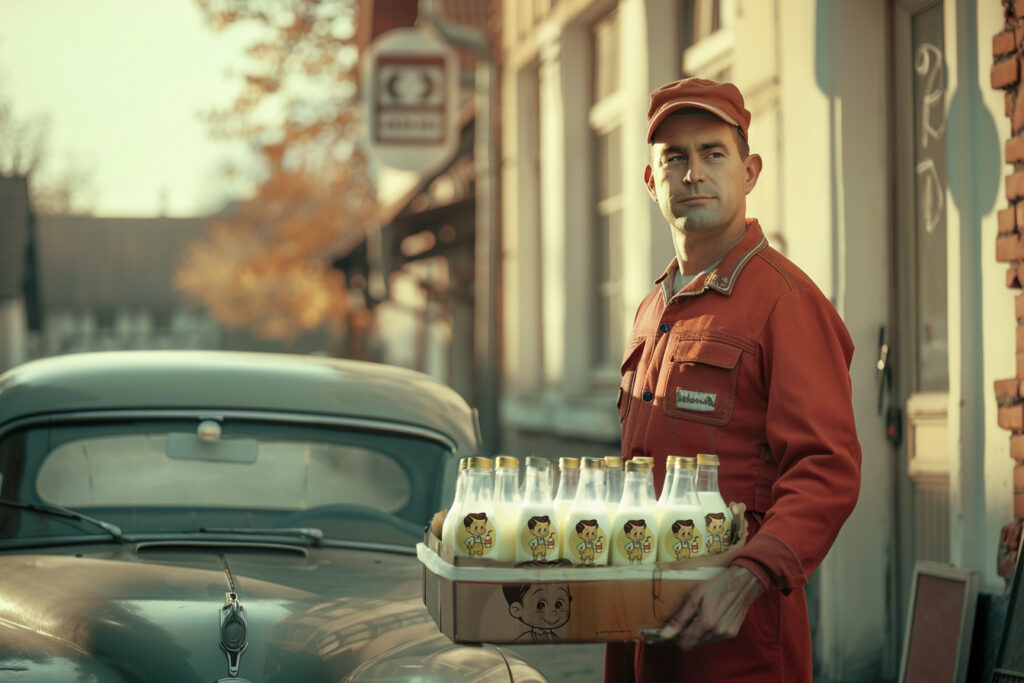Two examples of the Milkman concept
The traditional Milkman story harks back to the days when men would deliver fresh milk daily, leaving a bottle at your doorstep in the morning for your family’s consumption. After finishing the milk, you’d leave the empty glass outside to be refilled by the Milkman. This concept goes beyond just a business idea; it was part of a bygone era when families enjoyed healthy and fresh milk. Now, in the age of sustainable branding, this concept has caught the attention of experts across various fields, from designers and brand developers to business innovators and society at large. We all yearn for a world with minimal waste. While the bottles we use may be recyclable, reusing them through the Milkman model can significantly conserve resources.

Despite the clear benefits, some consumers may find this approach psychologically jarring, feeling like a step back in time. It could imply a return to a more manual process, which contrasts with our modern reliance on technology for convenience. Embracing the Milkman concept may involve a slight shift in mindset for users accustomed to effortless, tech-driven solutions.
In visual communication, it’s essential to evoke feelings of modernity, fun, and family-friendliness, while optimizing the Milkman concept to align with contemporary lifestyles.
Picnic BV: Reinventing the Milkman for the Modern Era
This is precisely what Picnic BV has achieved, reviving the Milkman model for the 21st century
Picnic BV’s innovative approach to revitalizing the Milkman concept in the 21st century involved a fusion of tradition, sustainability, and cutting-edge technology. The company introduced Milkman 2.0 by leveraging electric vans for deliveries and reusable totes for packaging, connecting with customers on a community level committed to waste reduction. Behind the scenes, Picnic utilized data analytics to optimize routes, ensure vehicle efficiency, and maintain safety standards. This modern Milkman legacy not only focused on sustainability but also on providing a seamless, customer-centric experience through visual communication and a promise of zero waste, one tote at a time. Picnic BV‘s revival of the Milkman concept resonated with families by bridging the past with the present, all while quietly transforming urban distribution.
I firmly believe that the success story of Picnic BV should serve as a compelling case study for every design office that values sustainable branding. We need to amplify these examples of forward-thinking businesses, leading the way toward a more environmentally conscious future.
TheWaterBean: Filtering Sustainability into Everyday Glassware
A striking illustration of applying this ethos on a smaller scale can be found in the innovative concept of The Waterbean. This initiative not only focuses on filtering plastic bottles for extended use, reducing plastic waste significantly but also integrates this technology into traditional glass water containers. By effortlessly keeping water clean, The Waterbean is revolutionizing both packaging and product design. The introduction of reusable glasses in their stores adds another layer of sustainability to their mission.
At Ideera, we are dedicated to sharing such impactful stories with our community, aiming to inspire them with the success of The Waterbean and to glean insights from the trailblazing approach of Picnic BV. It is through learning and embracing such initiatives that we can collectively shape a more sustainable and eco-friendly future.

I am Shawkash, a seasoned product designer with a knack for both digital and physical products. In 2015, I embarked on a journey with Ideera, a venture I founded with the vision of propelling startups and new businesses to success, nurturing them to become the future’s big brands. My portfolio boasts collaborations with renowned brands such as Unilever, Bang and Olsfen, United Nations, and Flexjet. My commitment to sustainability is not just a preference, but a recognition, as evidenced by the award I received from UNESCO for my contributions to combatting global warming. Therefore, it’s only natural that I gravitate towards designing for and collaborating with sustainable brands. Looking forward to creating a greener future together!
